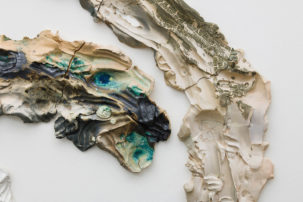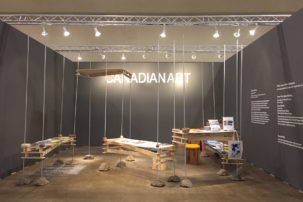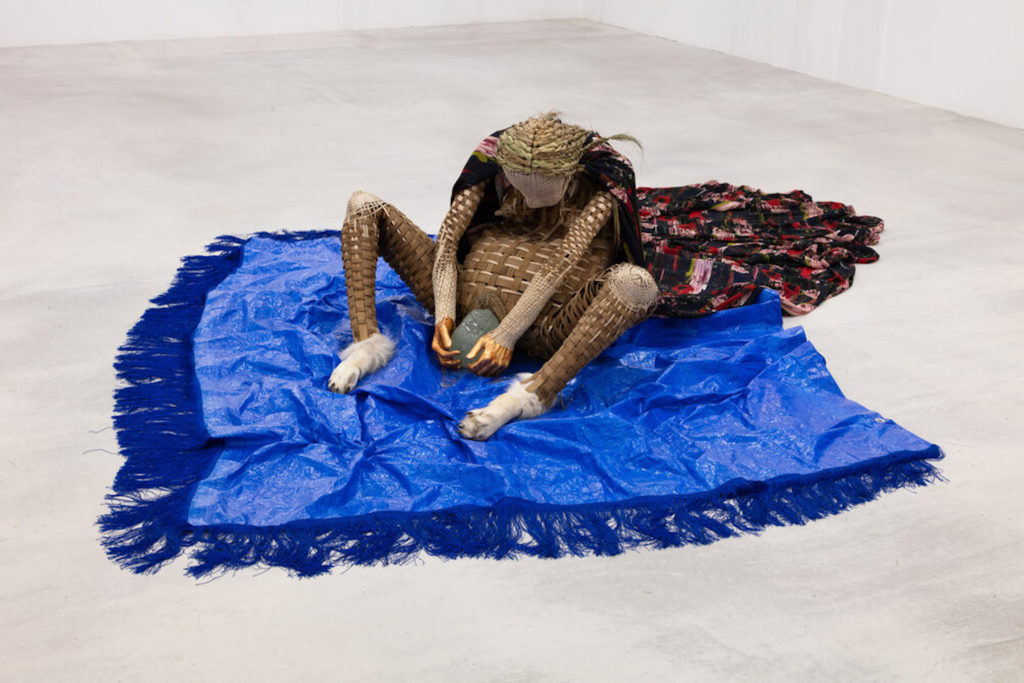 Merritt Johnson, Necessity Channeling Creation, 2020. Woven black ash and reed, sweetgrass, resin, textile, taxidermy wolf’s feet, tarp.
Merritt Johnson, Necessity Channeling Creation, 2020. Woven black ash and reed, sweetgrass, resin, textile, taxidermy wolf’s feet, tarp.
Patel Brown, a venture by Devan Patel, of Patel Gallery, and Gareth Brown-Jowett, former director of Division Gallery and Arsenal, recently opened a 4,000-square-foot gallery in the west end of Toronto. Their online booth for Art Toronto will feature sculptures, textile works, paintings, photographs and works on paper by an impressive roster of artists including Shuvinai Ashoona, Nicolas Fleming, Alexa Hatanaka, Anique Jordan, Ness Lee, Oluseye, Rajni Perera, Nep Sidhu and Shellie Zhang. Patel and Brown-Jowett have excellent taste, so this is sure to be a must-see. My favourite work is Merritt Johnson’s show-stopping Necessity Channelling Creation (2020), a life-size sculpture that captures the act of giving birth. (There’s a great talk between Johnson and Perera on @patelbrowngallery’s IGTV channel). Works from the online booth will be installed in rotation at their 21 Wade Avenue location. –Yaniya Lee, senior editor-at-large
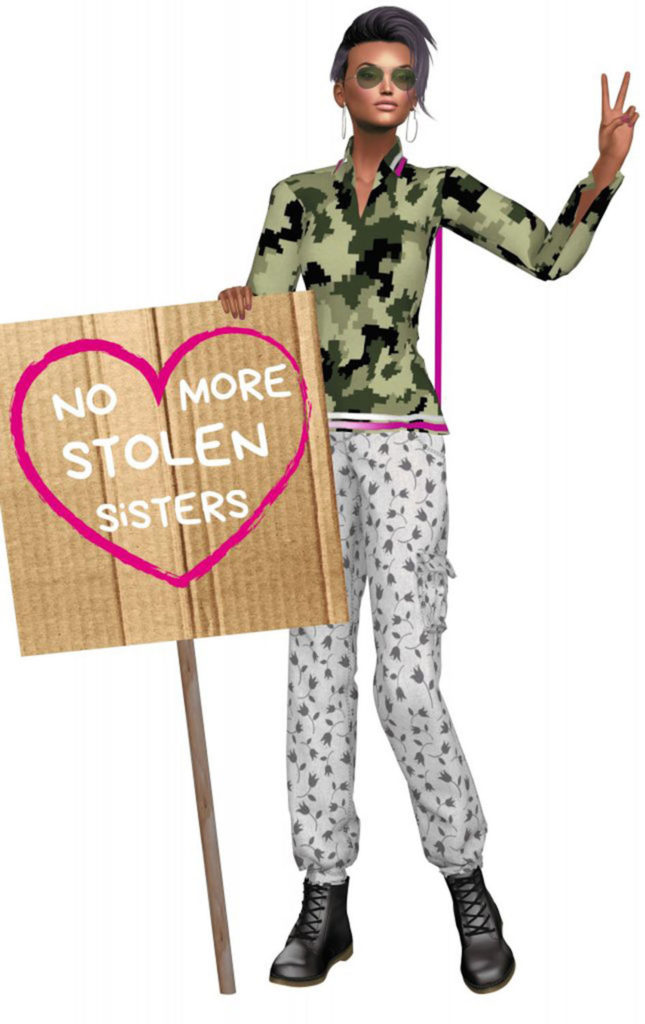 Skawennati, No More Stolen Sisters, 2020. Shaped archival pigment print on aluminum, 68 x 44 inches. © Skawennati / ELLEPHANT.
Skawennati, No More Stolen Sisters, 2020. Shaped archival pigment print on aluminum, 68 x 44 inches. © Skawennati / ELLEPHANT.
Drawing inspiration from traditional Haudenosaunee regalia and military-style clothing, Skawennati introduces a fashion collection, ResistanceWear, to demonstrate the impact of the colonization of Turtle Island through textiles and patterns. Using her digital art practice as a launching point, she decorates the gallery with large textile motifs, avatars and mannequins wearing her designs. Every avatar carries a protest sign as a demonstration of Indigenous resistance. In many ways, Skawennati not only reclaims space in the digital world, but also in the physical, with designs that reflect the ongoing, persistent protection of our ancestral territories. As a part of Art Toronto’s programming, ELLEPHANT (Montreal) will host a video of a tour of her just-opened exhibition, “Calico & Camouflage: Demonstrate,” followed by an artist talk at 7 p.m. EDT on October 29, all accessed through the gallery’s website. —Adrienne Huard, editor-at-large
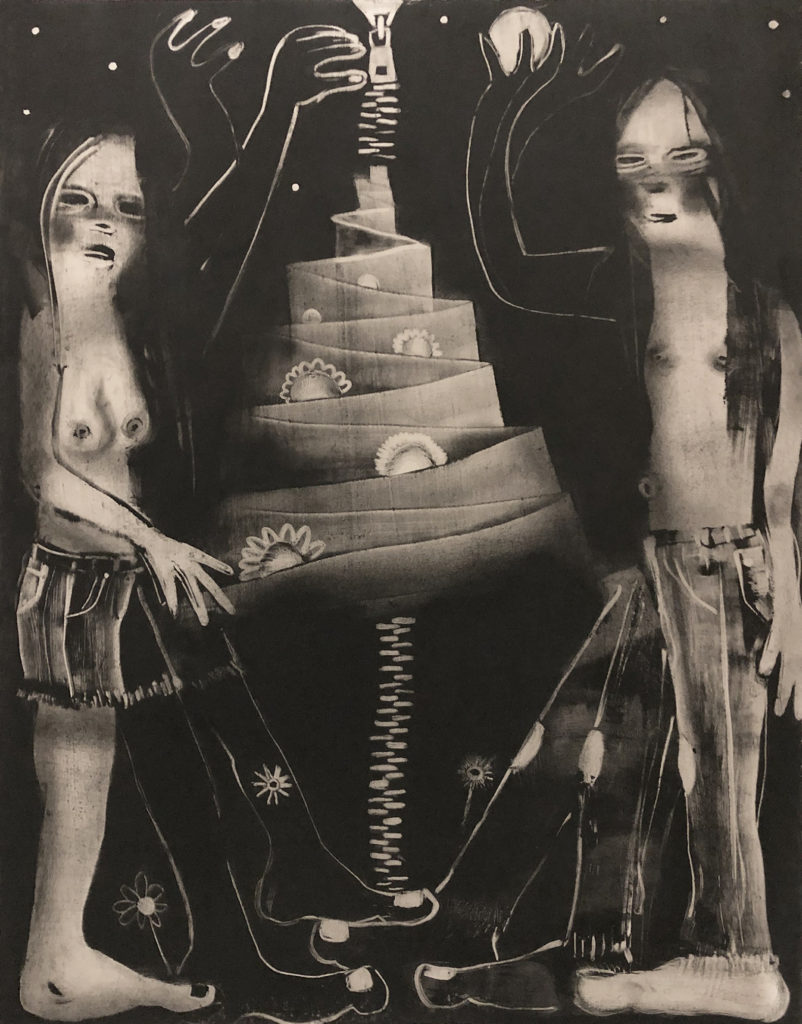 Bea Parsons, Jeans,Jeans,Jeans, 2020. Monotype print.
Bea Parsons, Jeans,Jeans,Jeans, 2020. Monotype print.
“Peyak” (the Cree word for the number one) was the first solo show of Montreal-based printmaker Bea Parsons, and the series of eight monotypes was shown at McBride Contemporain this fall. Her works explore language, identity and self, as Parsons reflects on her Cree and Scottish heritage. Steeped in modernism, they cheekily salute and deconstruct the great Western artistic masters she has studied. Parsons says the series began before the pandemic started, but as the shutdowns and social distancing became part of life, they became part of the series, too. In retrospect, some of the earlier works in this series, like the print titled simply 2020, created in January, feel prescient. Looking at her prints onscreen in a world of Zoom calls, livestreams, webinars and video screens, seems to raise a question: Just when is it okay to stare? For Art Toronto, Parsons’s work will be shown along with sculptures, paintings and collage works by Barry Allikas, Stephen Schofield, Lorraine Simms and Andrea Szilasi. —Ossie Michelin, editor-at-large
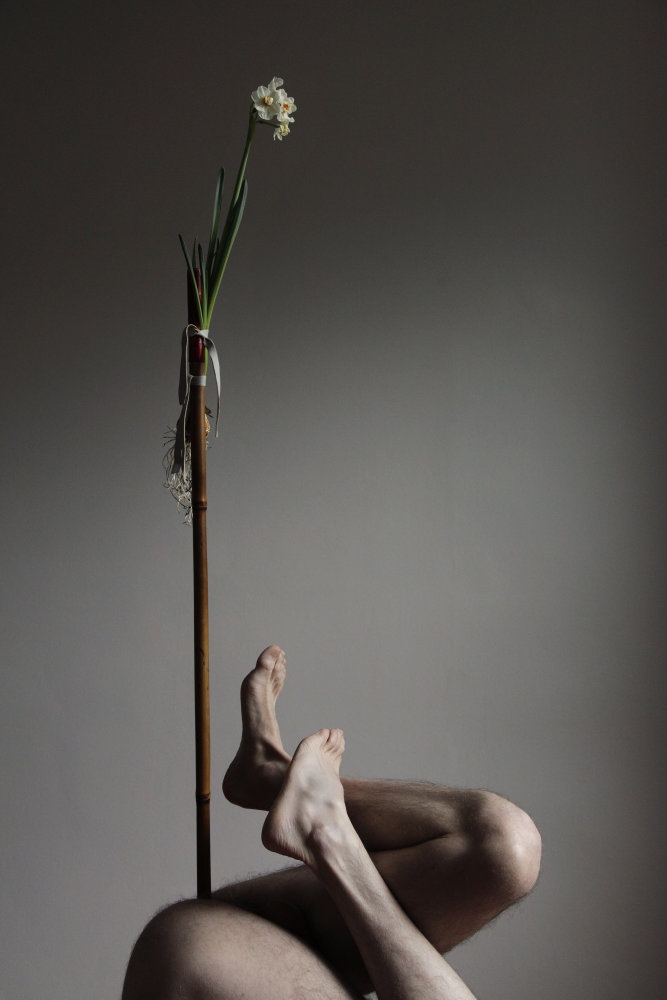 Benny Nemerofsky Ramsay, Arrangement No. 4 (My Favourite Vase), in collaboration with Bastien Pourtout, 2019. Inkjet print on Canson etching rag, 45 x 30 cm.
Benny Nemerofsky Ramsay, Arrangement No. 4 (My Favourite Vase), in collaboration with Bastien Pourtout, 2019. Inkjet print on Canson etching rag, 45 x 30 cm.
For those craving an in-person experience, Stephen Bulger Gallery is hosting an Art Toronto pop-up at its space on Dundas Street West. This collaborative effort is a small-scale version of the fair with Pierre-François Ouellette art contemporain (Montreal), Michael Gibson Gallery (London), TrépanierBaer (Calgary) and Wil Aballe Art Projects (Vancouver) all bringing works by artists from their rosters. The gallery put together a short video outlining the protocols in place to keep you safe and comfortable. At SBG, Pierre-François Ouellette presents a special collaboration with Benny Nemerofsky Ramsay, showing his Arrangements (2019) series—delicate, elegantly staged floral compositions that hover somewhere between still lifes and nudes—alongside Ed Pien’s Invasive Species (2020), ink drawings that depict squirming, expansive scenes of plant and insect hybrids, and Marie-Jeanne Musiol’s luminous photographic prints showing the electromagnetic fields of plant life. Kanien’kehá:ka/English artist Hannah Claus’s impressive wall work trade is ceremony (fire) (2019) uses needle-like copper pins pushed into a wool blanket to refer to trade between European settlers and Indigenous peoples, as well as to ceremonial practices and symbols; it’s a sophisticated treatment that blends identity with abstraction and is being shown in Toronto for the first time. —Jayne Wilkinson, editor-in-chief
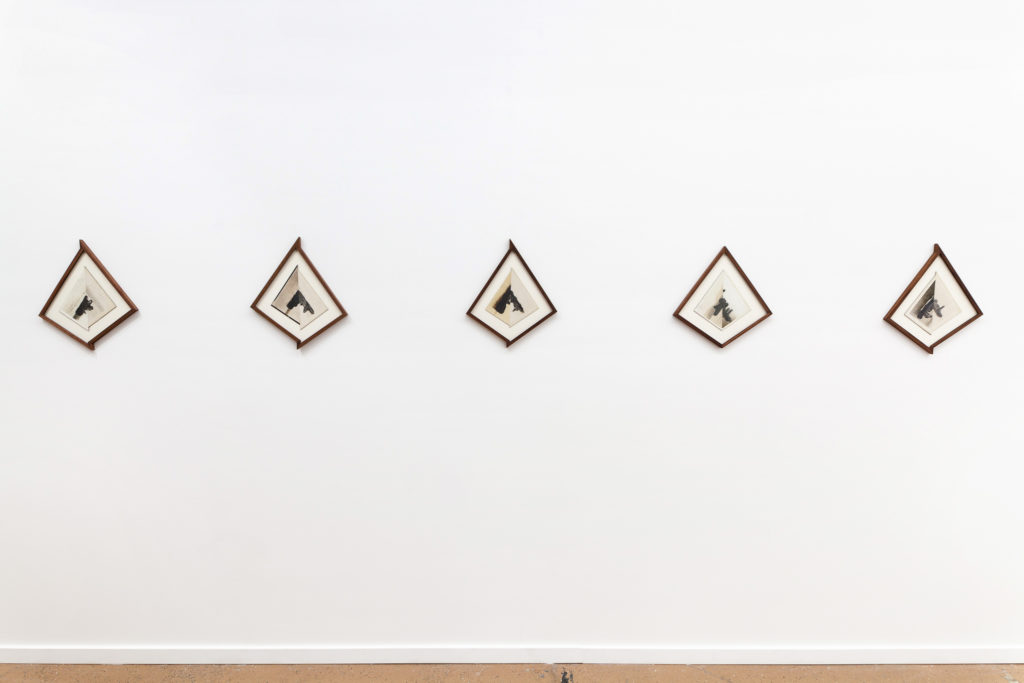 Robin Arseneault, Kites 1–5, 2020. Graphite on found silver gelatin prints. 9.25 x 8 inches. Courtesy Jarvis Hall Gallery.
Robin Arseneault, Kites 1–5, 2020. Graphite on found silver gelatin prints. 9.25 x 8 inches. Courtesy Jarvis Hall Gallery.
Jarvis Hall Gallery, with a physical space tucked in Calgary’s Barley Belt, is participating in Art Toronto this year with presentations of new work by Robin Arseneault, Mark Dicey, Laura Findlay, Kablusiak, Tyler Los-Jones, Sondra Meszaros, Yvonne Mullock, Marigold Santos, Corri-Lynn Tetz, Larissa Tiggelers and John Will. Unlike their quirky—and often phallic—drawings, Arseneault will be showing Kites (2020), a series of photo collages with peculiar frames made by Jarvis Hall, that seem to disorient and complicate the act of viewing. I’m also looking forward to Marigold Santos’s captivating landscapes. Drawing on imagined spaces and lived experiences of immigration, the paintings are mesmerizing and a must-see. —Sarah Sarofim, editorial resident
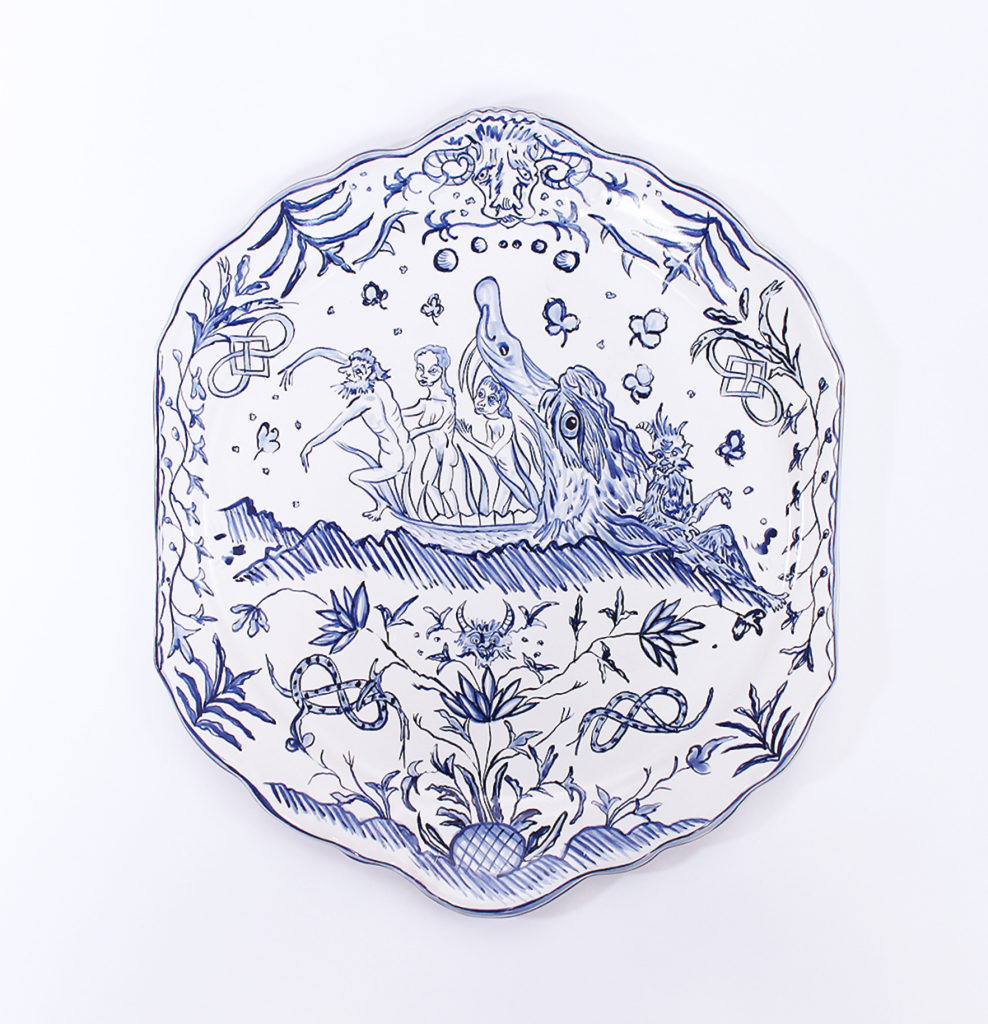 Lindsay Montgomery, Springtime on the Hellmouth, 2020. Tin-glazed earthenware, 34.3 x 29.2 x 3.8 cm.
Lindsay Montgomery, Springtime on the Hellmouth, 2020. Tin-glazed earthenware, 34.3 x 29.2 x 3.8 cm.
What started as a chance meeting for art collectors Abdelilah Chiguer and Norbert Langlois at an exhibition opening nearly a decade ago has steadily grown into a diverse, collecting-community hub centred around Galerie 3 in Quebec City. “We didn’t call it a gallery at first,” the pair explained earlier this year in Canadian Art’s Collecting Guide, “we began by working with the artists we collect and whose work we love…. Art bridges all different life experiences and interests, and that is a way to build community around art. This is how our small ecosystem should work.” It’s an essential point to consider, particularly for smaller regional galleries (Michael Gibson Gallery of London, also at Art Toronto this year, also comes to mind, among others) that are not only key to creating and maintaining sustainable local support networks for artists and collectors alike, but also represent and expand the audience and opportunities for contemporary art making outside of the major centres. For Art Toronto, Chiguer and Langlois are presenting a virtual and in-gallery exhibition of new works by conceptual art pranksters BGL, painters Martin Bureau and Dan Brault, and ceramicists Laurent Craste and Lindsay Montgomery. —Bryne McLaughlin, deputy editor
 Colleen Heslin, Gothic Horror, 2020. Ink and dye on sewn canvas, 78 x 88 inches. Courtesy the artist and Monte Clark Gallery.
Colleen Heslin, Gothic Horror, 2020. Ink and dye on sewn canvas, 78 x 88 inches. Courtesy the artist and Monte Clark Gallery.
For “In the Dark,” Colleen Heslin’s solo project with Monte Clark Gallery (Vancouver), the Powell River artist uses a dusky palette for stitched textiles. One wall work sews swaths of grey, coal, dust, iron and flint—waves of night nipped by grotto zones prismed mint, mustard, cobalt, rust; wine, calendula, chicory, sea; sand, splinter, cedar and salal. It’s all very natural as a 2020 mood board, but I can’t stop pinning Heslin’s elegant abstractions onto another kind of contemporary backing: glitch design. But where “glitch” implies something quick, techy and digital, Heslin’s process—like that of Angela Teng or Rebecca Brewer, two other BC artists I admire—is slow, analog and material. There are, though, aspects to Heslin’s practice I can appreciate fully online from a distance: her project The Last Woman Standing: An open letter to the British Museum documents an (eventually successful) request for the British Museum to change a wall text which had described a ancient Assyrian female figure as “unflattering.” Also, on her Instagram, Heslin’s calm pictures of drying, just-dyed fabrics, spread out amid large Douglas firs, serve as COVID-era balm. And in those images, you know, a sun still kind of shines. —Leah Sandals, content editor
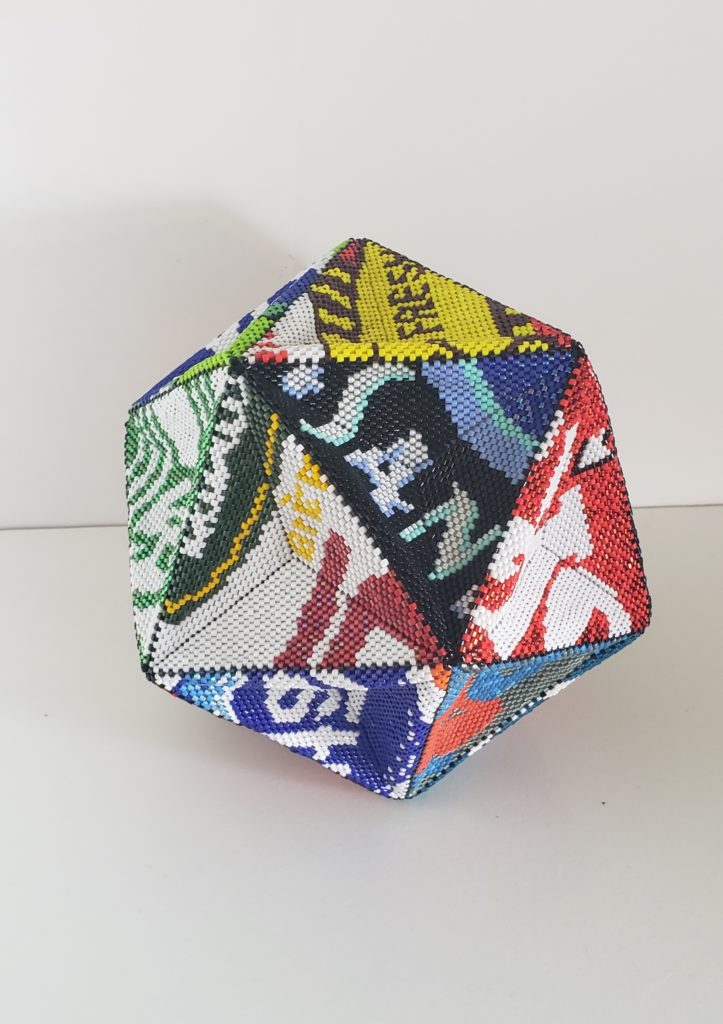 Nico Williams, Nibiikaa (“There is a lot of water”), 2020. 24,500 Delica beads and thread, 14 x 14 x 12.1 cm. Courtesy Wil Aballe Art Projects.
Nico Williams, Nibiikaa (“There is a lot of water”), 2020. 24,500 Delica beads and thread, 14 x 14 x 12.1 cm. Courtesy Wil Aballe Art Projects.
I’m really looking forward to Wil Aballe Art Projects’ (Vancouver) selection this year. It’s thoughtfully curated as an exhibition in two parts, with an in-person showing at Stephen Bulger Gallery’s collaborative pop-up in Toronto and an all-virtual presentation for Art Toronto’s FOCUS section that embraces the nature of the screen by showcasing video works. Works in physical space include an impressive line-up of Lyse Lemieux, Julia Rose Sutherland, Patryk Stasieczek, Vanessa Dion Fletcher, Charles Campbell, Maegan Hill-Carroll, Nico Williams, Francisco-Fernando Granados, Mark Verabioff, and more; with online (and some showing in-person) video works by Paul Wong, Syrus Marcus Ware, Alex Gibson, Zachery Longboy and Marina Roy, among others. The exhibition’s title, “Quid Tum?,” is a bit opaque until you learn that it translates from Latin to “What next? What’s next? Then what?”—and more meanings—all at once. It’s a concise phrase for a global converging of possibilities and consequences. I’ve been craving the kind of balance that WAAP’s selection strikes: between works that directly engage with crises and those that give pleasure in aesthetic forms—after all, these are not mutually exclusive conditions. Some of my favourites are Nico Williams’s vibrant beaded sculptures, Zachery Longboy’s Water into Fire (1994), Syrus Marcus Ware’s Ancestors (2019) and Alex Gibson’s animation VAL Sex Dream (2019). —Joy Xiang, assistant editor


